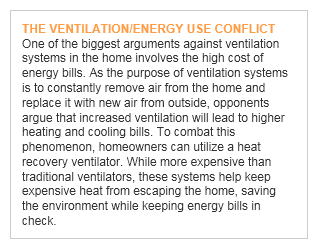
The first step in designing a ventilation system is to determine how much air is required. Interestingly, there are very few regulations relating to ventilation requirements, but the most widely accepted standard is that developed by ASHRAE. It recommends ventilation be geared towards providing 15cfm (0.425 cubic meters per minute) or 0.35 ACH per person living in the home. To put these numbers into more easy to understand values, 15 cfm means that 15 cubic feet of air, or 0.425 cubic meters, are being circulated through the house each minute. A ventilation rate of 0.35 ACH means that 35 percent of the air is being completely changed out for fresh air every single hour [source: Bower].
The most effective type of ventilation system for the home involves a balanced central system with local exhaust fans at the kitchen and restroom. Local fans should be carefully selected based on noise levels produced. To create a successful acoustic ventilation system, choose place existing fans away from the spaces they serve. A bathroom or kitchen exhaust fan can be placed in the attic and vented through the roof.
The central system should be comprised of two fans: one for supply and one for exhaust. Intakes grilles should be lined and supplied with sound dampers or attenuators designed for acoustic ventilation systems [source: Building Services and Environmental Engineering]. Again, fans should be placed away from the main living areas, such as bedrooms and sitting rooms. Lined ducts will carry air throughout the home and it will enter the room through ceiling-mounted supply grilles[source: MBS]. Exhaust vents are most useful in areas subject to pollutants and moisture, including bathrooms and kitchens.
Ventilation systems require very little actual maintenance, but you can prolong the life of your equipment and protect your investment by cleaning fan blades, cabinets and intake grilles semi-annually.
For all the benefits they provide, acoustic ventilation systems are surprisingly affordable. The most expensive balanced acoustic ventilation systems run around $1,000, as of early 2009 prices. Add in costs to install lined ducts, intake grilles, and supply vents, and you're still left with a relatively inexpensive project that costs well under $3,000 [source: New York State Energy Research and Development Authority].
References:
Bower, John. Understanding Ventilation. Indiana: The Healthy House Institute, 1995.
Building Services and Environmental Engineering. "Acoustic Ventilation from Greenwood." March 8, 2005. April 8, 2009http://www.bsee.co.uk/news/fullstory.php/aid/3181/Acoustic_ventilation_from_Greenwood.html.
Modern Building Services (MBS). "Acoustic Ventilation Delivers Fresh Air Without the Noise." August 2006. April 8, 2009http://www.modbs.co.uk/news/fullstory.php/aid/2312/Acoustic_ventilation__delivers_fresh_air__without_the_noise.html.
New York State Energy Research and Development Authority. "Homeowner's Guide to Ventilation." 2008. April 9, 2009.


